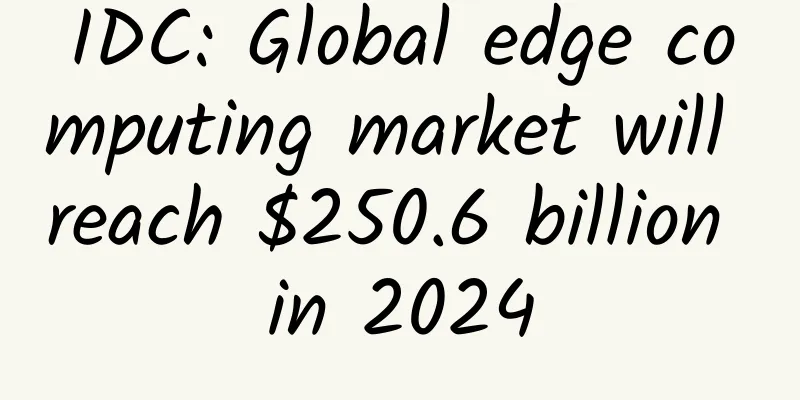IDC: Global edge computing market will reach $250.6 billion in 2024

|
Industry data: Gartner conducted a survey and interview of global government agencies in February this year. Among the 233 foreign government-related chief information officers surveyed, 85% believed that the services provided by their government agencies were mainly "passive response" and "passive response", while only 4% of government agencies "proactively" provided services. No chief information officer believed that the services provided by their government agencies were predictive and forward-looking. In contrast, some organizations in the Chinese government were able to grasp and utilize the power of advanced technology more quickly and effectively, especially during the epidemic, effectively improving response speed and service capabilities.
Gartner released important strategic technology trends that enterprises and organizations need to explore in 2021, including: Internet of Behaviors, Total Experience, Privacy-Enhancing Computation, Distributed Cloud, Anywhere Operations, Cybersecurity Mesh, Intelligent Composable Business, AI Engineering, and Hyperautomation. According to Gartner's latest forecast, China's IT spending is expected to reach 3.04 trillion in 2021, an increase of 7.2% compared to 2020. China's IT spending is expected to reach 2.84 trillion in 2020, an increase of 1.3% compared to 2019. Global IT spending is expected to reach 3.8 trillion US dollars in 2021, an increase of 4% compared to 2020. Global IT spending is expected to reach 3.6 trillion US dollars in 2020, a decrease of 5.4% compared to 2019. According to IDC's latest Global Edge Spending Guide, the global edge computing market will reach $250.6 billion by 2024, with a compound annual growth rate (CAGR) of 12.5% during the 2019-2024 forecast period. IDC expects edge spending to be concentrated in the United States and Western Europe in the next few years. By 2020, the Americas, EMEA, and Asia Pacific will account for 45.0%, 27.9%, and 27.2% of global spending, respectively. From an industry perspective, 11 of the 19 standard industries will account for 5% or more of global total spending by 2020. Throughout the forecast, the top two industries for edge spending are discrete manufacturing and professional services, and by the end of the forecast period, retail will surpass process manufacturing to become the third largest industry with the most spending. Edge spending in the professional services sector is growing the fastest, with a five-year compound annual growth rate of 15.4%. Juniper Networks announced that it has signed an agreement to acquire 128 Technology, a Burlington, Massachusetts-based vendor of software platforms that support enterprise networks, for $450 million. The transaction is expected to be completed in Juniper's fourth fiscal quarter. Founded in 2014, 128 Technology provides a software-based virtual router platform that connects an enterprise's offices, data centers, and public cloud deployments. It is designed to replace the traditional physical routers that enterprises used for this task in the past, with benefits including reduced operating costs and simplified daily management operations. Financial report data: According to Microsoft's first quarter financial report, Microsoft's profit increased by 30% from the same period last year to US$13.9 billion, or US$1.82 per share, exceeding analysts' expectations of US$1.54. Revenue was US$37.2 billion, up 12%, far higher than the expected US$35.76 billion. According to SAP's third-quarter financial report, SAP's earnings per share in the third quarter were 1.32 euros (1.56 U.S. dollars) and revenue was 6.54 billion euros (7.8 billion U.S. dollars), down 4% from the same period last year. Among them, the cloud business performed strongly, with revenue growing to 1.98 billion euros in the quarter, up 10% from the same period last year. Software license revenue fell 23% year-on-year to 710 million euros. In addition, cloud and software revenue was 5.54 billion euros, down 2% year-on-year. IBM's third-quarter revenue fell 3.1% from the same period last year to $17.6 billion. This is the 29th time in the past 33 quarters that the company has seen revenue decline. However, total cloud computing revenue increased 19% to $6 billion and reached $24.4 billion in the past 12 months, an adjusted increase of 25%. Micron Technology announced its fourth-quarter 2020 results, with revenue of $6.06 billion from sales of DRAM and NAND flash memory chips used in USB and small devices, up from $4.87 billion in the same period last year. Wall Street had expected earnings per share of 98 cents and revenue of $5.89 billion. Programmable chip maker Xilinx released its second-quarter revenue and profit report. By geographic location, Xilinx's biggest improvement came from Europe, where sales increased by 47% compared to the first quarter and 10% compared to the same period last year, while sales in North America increased by 20% compared to the first quarter. By product line, Xilinx's strongest growth came from data center products. Data center revenue accounted for 14% of total revenue, up 23% from the previous quarter and 30% from the previous year. |
<<: Omdia: In the third quarter of 2020, 109 commercial 5G networks were launched worldwide
>>: We need to look up to the stars (6G) and keep our feet on the ground (5G)
Recommend
Shifting gears to 5G: Operators will experience both hardship and sweetness in 2019
Recently, the three major operators have released...
Yecao Cloud New Year Special Offer, Hong Kong VPS Annual Payment 36% Off, Starting from 136 Yuan in the First Year
Sharing some information about Chinese VPS mercha...
These router phenomena must have troubled you. Take a look and learn more
Does the row of indicator lights on your router o...
Seven distributed global ID generation strategies, which one do you prefer?
[[415300]] After using microservices, many proble...
How is the SSH protocol? Why does a normal connection suddenly report an Identification error?
SSH SSH is mainly a connection protocol. Why do w...
Talking about new IP technology in data centers
Ethernet technology, also known as IP technology,...
High-performance IO model: Reactor vs Proactor, how does it work?
We all know that a lot of ideas in the field of s...
DiyVM: Starting from 50 yuan/month - dual core, 2G memory, 50G hard disk, Hong Kong/Japan/Los Angeles data center
DiyVM is a relatively low-key Chinese hosting com...
SD-WAN industry development requires VNF evolution
Like any successful technology, the Software Defi...
Cisco fully enhances Webex to lead global collaboration with innovative experiences
In the wave of full digitalization, enterprises n...
11 key visualizations for SD-WAN success
SD-WAN deployments are quickly becoming a major f...
CDN has so many derivatives?! Yunfan Accelerator takes advantage of technological innovation to conquer the new blue ocean of short videos
[51CTO.com original article] 2017 has quietly pas...
Let’s talk about how 5G applications can empower thousands of industries
Based on the transmission characteristics of lar...
The 5G Spring Festival Gala is coming, but who will ensure its security?
The Chinese New Year is getting closer and closer...
Five pictures to solve FTP
FTP Principle and Configuration FTP is a protocol...









